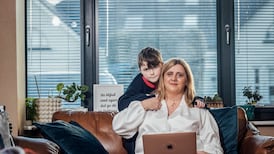Gas masks from the second World War, a glass ink well, monogrammed tiles and marbles – just a few of the treasures unearthed by 250 volunteers digging at the site of the Guinness family mansion in St Anne’s Park, Raheny, Dublin, in recent weeks.
Dating back to 1873, St Anne’s House was home to brewer Arthur Guinness’s grandson, Sir Arthur Edward Guinness or Lord Ardilaun. The house was destroyed by a fire in 1943, at a time when it was vacant, and later demolished. In 2021, Dublin City Council introduced a community archaeology programme in the park, which has run for a number of weeks in early autumn every year since.
Now in its fourth year, and growing more and more popular, this year’s dig came to an end on Tuesday after five busy weeks.
The project’s site director, archaeologist James Kyle, says more than 20,000 people came to visit the site of the house during this period. Many visitors dropped by to share personal stories from their youth, of playing in the ruins of the house before its demolition in 1968, with a few able to remember a time before it went up in flames.
READ MORE
“The mansion looms very large in people’s history, whether they grew up here in the 1950s and ‘60s, or even the older generation still remember the mansion before it burnt down in 1943,” Kyle says.
Artefacts discovered on the dig were put on display out front at the “finds table” so that observers and passersby could inspect these remnants of the past.
Susie McAdam (16), a transition year student from Holy Faith Clontarf, took part in the project’s educational outreach programme, joining nine other students from different schools every Tuesday for four weeks.
Aside from making new friends, McAdam made some exciting discoveries, including “part of a gas mask and tile mosaics still together on the floor where the porch was” as well as “lots of glass and decorated plaster from the walls” of the mansion.
“You’d just be finding rocks and stuff and then suddenly you find something exciting. It was really nice to find something different and new.”
Fellow transition year student Áine O’Brien (15), from Clontarf Community School, found the experience “really cool” but “also really tiring”. “You don’t realise that it’s so meticulous and labour-intensive. You’re on your knees all day, scraping away with your trowel.”
Like McAdam, uncovering the mosaic tiling was a highlight of the four-week course for O’Brien. “It was under just a few layers of dust. I brushed something away and it was just there,” she says.
Orla Brennan, who volunteered for two weekends with her sister Gráinne, could also vouch for the tiring yet rewarding nature of the work, adding that they “had great banter on the site”.
“It’s hard work. You’re moving quite a lot of material but doing it very slowly ... I would do it in a heartbeat again. It’s very addictive.”
Canadian Charlotte Ens (22) says the community-driven nature of the dig inspired her to take the leap and sign up as a volunteer.
Having visited Ireland the previous summer to take part in an archaeology course with the University of Galway, Ens made the move to Dublin this August to begin her master’s in archaeology at UCD. She attended a seminar series at the Royal Irish Academy during National Heritage Week, where she heard about the community dig in St Anne’s Park.
I realised that what to everyone else just looked like a heap of grass, all the ruins they were excavating at the time, suddenly came to life for me
“It was a great way, not only to get practical hands-on experience for me as a student that wants to become an archaeologist, but also to connect with people that actually are from the area and can teach me things and who I can learn from,” she says.
For Ens, who developed “a particular interest in doing archaeology for the public and with the public” during her undergraduate degree in anthropology, such projects are important because they demonstrate “how archaeology can really bring people together”.
The best part of being involved was getting “to see how much it meant, not only for the volunteers who were really invested in what they were doing and really passionate, but also to the people who came up just to learn about what was going on,” Ens says.
Witnessing the dig progress over the last number of years has sparked the imagination of many locals, including student Susie McAdam’s father, artist Barry McAdam. Together with his wife Sinéad, he runs Naniken Studio, named after the river running through St Anne’s Park.
“We create a lot of artwork based around St Anne’s Park and north Dublin as well so we’ve got a real passion for the area,” he says. He has developed his own project inspired by the archaeological work happening near their home.
[ A life in Guinness: opening my great-grandfather’s fileOpens in new window ]
Last autumn, after seeing the dig in full swing and speaking to local historian Leo ‘George’ Devitt, he decided to build a model of the Guinness mansion. “I got card literally that night and just started to build room after room,” he recalls.
“I realised that what to everyone else just looked like a heap of grass, all the ruins they were excavating at the time, suddenly came to life for me.”
He describes being in awe of “just how vast it was ... it was almost more like a palace than a house”. “By looking at the map and then looking at the photographs, I was able to join the bits together and go, ‘Oh yeah that photograph was taken here, or there’ and that gave it a real sense of life.”
Having completed a degree in product design, he was already familiar with building scale models. Combining the floor plans and black and white images of the house with an AI tool, McAdam was able to colourise the building and “see just how vibrant everything was within the rooms”, including the extravagant Palm Garden and the grand staircase leading into the main hall.
Taking his idea one step further, he collaborated with visiting French students Suzanne Robert and Mamady Baradji, from Ulster University, who created a virtual reality 3D-model of the house. Using a Meta headset, he has been able to walk through the mansion’s rooms, an experience he hopes to share with others in future.
Speaking about his plans to continue working on the project, he says he wants to turn the card model “into something more permanent and bigger to give back” to the park or library in Raheny.
- Sign up for push alerts and have the best news, analysis and comment delivered directly to your phone
- Find The Irish Times on WhatsApp and stay up to date
- Our In The News podcast is now published daily – Find the latest episode here



















